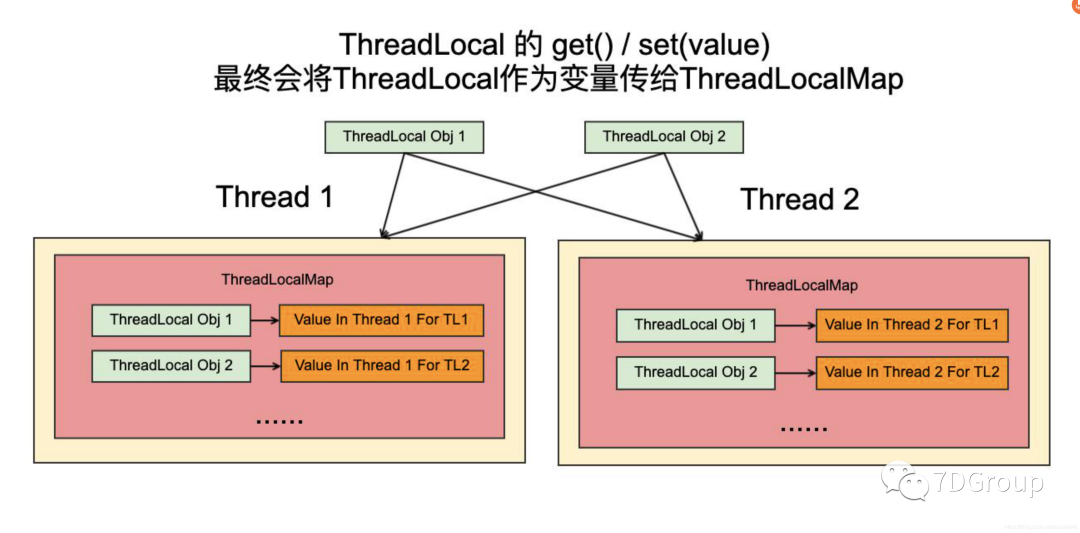ThreadLocal:線程專屬的變量
一、ThreadLocal 簡介
ThreadLocal是 java 提供的一個方便對象在本線程內(nèi)不同方法中傳遞和獲取的類。用它定義的變量,僅在本線程中可見和維護(hù),不受其他線程的影響,與其他線程相互隔離。
那 ThreadLocal 到底解決了什么問題,又適用于什么樣的場景?
- This class provides thread-local variables. These variables differ from their normal counterparts in that each thread that accesses one (via its get or set method) has its own, independently initialized copy of the variable. ThreadLocal instances are typically private static fields in classes that wish to associate state with a thread (e.g., a user ID or Transaction ID). Each thread holds an implicit reference to its copy of a thread-local variable as long as the thread is alive and the ThreadLocal instance is accessible; after a thread goes away, all of its copies of thread-local instances are subject to garbage collection (unless other references to these copies exist).
核心意思是
ThreadLocal 提供了線程本地的實例。它與普通變量的區(qū)別在于,每個使用該變量的線程都會初始化一個完全獨立的實例副本。ThreadLocal 變量通常被private static修飾。當(dāng)一個線程結(jié)束時,它所使用的所有 ThreadLocal 相對的實例副本都可被回收。
總的來說,ThreadLocal 適用于每個線程需要自己獨立的實例且該實例需要在多個方法中被使用,也即變量在線程間隔離而在方法或類間共享的場景。后文會通過實例詳細(xì)闡述該觀點。另外,該場景下,并非必須使用 ThreadLocal ,其它方式完全可以實現(xiàn)同樣的效果,只是 ThreadLocal 使得實現(xiàn)更簡潔。
二、ThreadLocal 使用
ThreadLocal 通過 set 方法可以給變量賦值,通過 get 方法獲取變量的值。當(dāng)然,也可以在定義變量時通過 ThreadLocal.withInitial 方法給變量賦初始值,或者定義一個繼承 ThreadLocal 的類,然后重寫 initialValue 方法。
下面通過如下代碼說明 ThreadLocal 的使用方式:
- public class TestThreadLocal
- {
- private static ThreadLocal<StringBuilder> builder = ThreadLocal.withInitial(StringBuilder::new);
- public static void main(String[] args)
- {
- for (int i = 0; i < 5; i++)
- {
- new Thread(() -> {
- String threadName = Thread.currentThread().getName();
- for (int j = 0; j < 3; j++)
- {
- append(j);
- System.out.printf("%s append %d, now builder value is %s, ThreadLocal instance hashcode is %d, ThreadLocal instance mapping value hashcode is %d\n", threadName, j, builder.get().toString(), builder.hashCode(), builder.get().hashCode());
- }
- change();
- System.out.printf("%s set new stringbuilder, now builder value is %s, ThreadLocal instance hashcode is %d, ThreadLocal instance mapping value hashcode is %d\n", threadName, builder.get().toString(), builder.hashCode(), builder.get().hashCode());
- }, "thread-" + i).start();
- }
- }
- private static void append(int num) {
- builder.get().append(num);
- }
- private static void change() {
- StringBuilder newStringBuilder = new StringBuilder("HelloWorld");
- builder.set(newStringBuilder);
- }
- }
在例子中,定義了一個 builder 的 ThreadLocal 對象,然后啟動 5 個線程,分別對 builder 對象進(jìn)行訪問和修改操作,這兩個操作放在兩個不同的函數(shù) append、change 中進(jìn)行,兩個函數(shù)訪問 builder 對象也是直接獲取,而不是放入函數(shù)的入?yún)⒅袀鬟f進(jìn)來。
代碼輸出如下:
- thread-0 append 0, now builder value is 0, ThreadLocal instance hashcode is 796465865, ThreadLocal instance mapping value hashcode is 566157654
- thread-0 append 1, now builder value is 01, ThreadLocal instance hashcode is 796465865, ThreadLocal instance mapping value hashcode is 566157654
- thread-4 append 0, now builder value is 0, ThreadLocal instance hashcode is 796465865, ThreadLocal instance mapping value hashcode is 654647086
- thread-3 append 0, now builder value is 0, ThreadLocal instance hashcode is 796465865, ThreadLocal instance mapping value hashcode is 1803363945
- thread-2 append 0, now builder value is 0, ThreadLocal instance hashcode is 796465865, ThreadLocal instance mapping value hashcode is 1535812498
- thread-1 append 0, now builder value is 0, ThreadLocal instance hashcode is 796465865, ThreadLocal instance mapping value hashcode is 2075237830
- thread-2 append 1, now builder value is 01, ThreadLocal instance hashcode is 796465865, ThreadLocal instance mapping value hashcode is 1535812498
- thread-3 append 1, now builder value is 01, ThreadLocal instance hashcode is 796465865, ThreadLocal instance mapping value hashcode is 1803363945
- thread-4 append 1, now builder value is 01, ThreadLocal instance hashcode is 796465865, ThreadLocal instance mapping value hashcode is 654647086
- thread-0 append 2, now builder value is 012, ThreadLocal instance hashcode is 796465865, ThreadLocal instance mapping value hashcode is 566157654
- thread-0 set new stringbuilder, now builder value is HelloWorld, ThreadLocal instance hashcode is 796465865, ThreadLocal instance mapping value hashcode is 1773033190
- thread-4 append 2, now builder value is 012, ThreadLocal instance hashcode is 796465865, ThreadLocal instance mapping value hashcode is 654647086
- thread-4 set new stringbuilder, now builder value is HelloWorld, ThreadLocal instance hashcode is 796465865, ThreadLocal instance mapping value hashcode is 700642750
- thread-3 append 2, now builder value is 012, ThreadLocal instance hashcode is 796465865, ThreadLocal instance mapping value hashcode is 1803363945
- thread-3 set new stringbuilder, now builder value is HelloWorld, ThreadLocal instance hashcode is 796465865, ThreadLocal instance mapping value hashcode is 1706743158
- thread-2 append 2, now builder value is 012, ThreadLocal instance hashcode is 796465865, ThreadLocal instance mapping value hashcode is 1535812498
- thread-2 set new stringbuilder, now builder value is HelloWorld, ThreadLocal instance hashcode is 796465865, ThreadLocal instance mapping value hashcode is 1431127699
- thread-1 append 1, now builder value is 01, ThreadLocal instance hashcode is 796465865, ThreadLocal instance mapping value hashcode is 2075237830
- thread-1 append 2, now builder value is 012, ThreadLocal instance hashcode is 796465865, ThreadLocal instance mapping value hashcode is 2075237830
- thread-1 set new stringbuilder, now builder value is HelloWorld, ThreadLocal instance hashcode is 796465865, ThreadLocal instance mapping value hashcode is 1970695360
- 從輸出中 1~6 行可以看出,不同線程訪問的是同一個 builder 對象(不同線程輸出的 ThreadLocal instance hashcode 值相同),但是每個線程獲得的 builder 對象存儲的實例 StringBuilder 不同(不同線程輸出的 ThreadLocal instance mapping value hashcode值不相同)。
- 從輸出中1~2、9~10 行可以看出,同一個線程中修改 builder 對象存儲的實例的值時,并不會影響到其他線程的 builder 對象存儲的實例(thread-4 線程改變存儲的 StringBuilder 的值并不會引起 thread-0 線程的 ThreadLocal instance mapping value hashcode 值發(fā)生改變)
- 從輸出中 9~13 行可以看出,一個線程對 ThreadLocal 對象存儲的值發(fā)生改變時,并不會影響其他的線程(thread-0 線程調(diào)用 set 方法改變本線程 ThreadLocal 存儲的對象值,本線程的 ThreadLocal instance mapping value hashcode 發(fā)生改變,但是 thread-4 的 ThreadLocal instance mapping value hashcode 并沒有因此改變)。
三、ThreadLocal 原理
ThreadLocal 能在每個線程間進(jìn)行隔離,其主要是靠在每個 Thread 對象中維護(hù)一個 ThreadLocalMap 來實現(xiàn)的。因為是線程中的對象,所以對其他線程不可見,從而達(dá)到隔離的目的。那為什么是一個 Map 結(jié)構(gòu)呢。主要是因為一個線程中可能有多個 ThreadLocal 對象,這就需要一個集合來進(jìn)行存儲區(qū)分,而用 Map 可以更快地查找到相關(guān)的對象。ThreadLocalMap 是 ThreadLocal 對象的一個靜態(tài)內(nèi)部類,內(nèi)部維護(hù)一個 Entry 數(shù)組,實現(xiàn)類似 Map 的 get 和 put 等操作,為簡單起見,可以將其看做是一個 Map,其中 key 是 ThreadLocal 實例,value 是 ThreadLocal 實例對象存儲的值。
ThreadLocalMap
四、ThreadLocal 適用場景
如上文所述,ThreadLocal 適用于如下場景:
每個線程需要有自己單獨的實例,如實現(xiàn)每個線程單例類或每個線程上下文信息(例如事務(wù)ID)。
ThreadLocal 適用于變量在線程間隔離且在方法間共享的場景,提供了另一種擴展 Thread 的方法。如果要保留信息或?qū)⑿畔囊粋€方法調(diào)用傳遞到另一個方法,則可以使用 ThreadLocal 進(jìn)行傳遞。
由于不需要修改任何方法,因此可以提供極大的靈活性。
1、案例一
這里一個處理 flag 的類,通過 ThreadLocal 使用,可以保證每個請求都擁有唯一的一個追蹤標(biāo)記。
- public class TestFlagHolder {
- private final static ThreadLocal<String> TEST_FLAG = new ThreadLocal<>();
- public static void set(String value) {
- TEST_FLAG.set(value);
- }
- public static String get() {
- return TEST_FLAG.get();
- }
- public static String get4log() {
- if (TEST_FLAG.get() == null) {
- return "-";
- }
- return TEST_FLAG.get();
- }
- public static void remove() {
- TEST_FLAG.remove();
- }
- }
2、案例二
在同一線程中 trace 信息的傳遞:
- ThreadLocal<String> traceContext = new ThreadLocal<>();
- String traceId = Tracer.startServer();
- traceContext.set(traceId) //生成trace信息 傳入threadlocal
- ...
- Tracer.startClient(traceContext.get()); //從threadlocal獲取trace信息
- Tracer.endClient();
- ...
- Tracer.endServer();
3、案例三
給同一個請求的每一行日志增加一個相同的標(biāo)記。這樣,只要拿到這個標(biāo)記就可以查詢到這個請求鏈路上所有步驟的耗時了,我們把這個標(biāo)記叫做 requestId,我們可以在程序的入口處生成一個 requestId,然后把它放在線程的上下文中,這樣就可以在需要時隨時從線程上下文中獲取到 requestId 了。
簡單的代碼實現(xiàn)就像下面這樣:
- String requestId = UUID.randomUUID().toString();
- ThreadLocal<String> tl = new ThreadLocal<String>(){
- @Override
- protected String initialValue() {
- return requestId;
- }
- }; //requestId存儲在線程上下文中
- long start = System.currentTimeMillis();
- processA();
- Logs.info("rid : " + tl.get() + ", process A cost " + (System.currentTimeMillis() - start)); // 日志中增加requestId
- start = System.currentTimeMillis();
- processB();
- Logs.info("rid : " + tl.get() + ", process B cost " + (System.currentTimeMillis() - start));
- start = System.currentTimeMillis();
- processC();
- Logs.info("rid : " + tl.get() + ", process C cost " + (System.currentTimeMillis() - start));
有了 requestId,你就可以清晰地了解一個調(diào)用鏈路上的耗時分布情況了。
五、小結(jié)
無論是單體系統(tǒng)還是微服務(wù)化架構(gòu),無論是鏈路打標(biāo)還是服務(wù)追蹤,你都需要在系統(tǒng)中增加 TraceId,這樣可以將你的鏈路串起來,給你呈現(xiàn)一個完整的問題場景。如果 TraceId 可以在客戶端上生成,在請求業(yè)務(wù)接口的時候傳遞給服務(wù)端,那么就可以把客戶端的日志體系也整合進(jìn)來,對于問題的排查幫助更大。
同時,在全鏈路壓測框架中,Trace 信息的傳遞功能是基于 ThreadLocal 的。但實際業(yè)務(wù)中可能會使用異步調(diào)用,這樣就會丟失 Trace 信息,破壞了鏈路的完整性。所以在實際的項目建議大家不要輕意使用 ThreadLocal。
參考資料:
[1]:《高并發(fā)系統(tǒng)設(shè)計40問》
[2]:https://juejin.cn/post/6844904016288317448#heading-6
本文轉(zhuǎn)載自微信公眾號「7DGroup」,可以通過以下二維碼關(guān)注。轉(zhuǎn)載本文請聯(lián)系7DGroup公眾號。












































